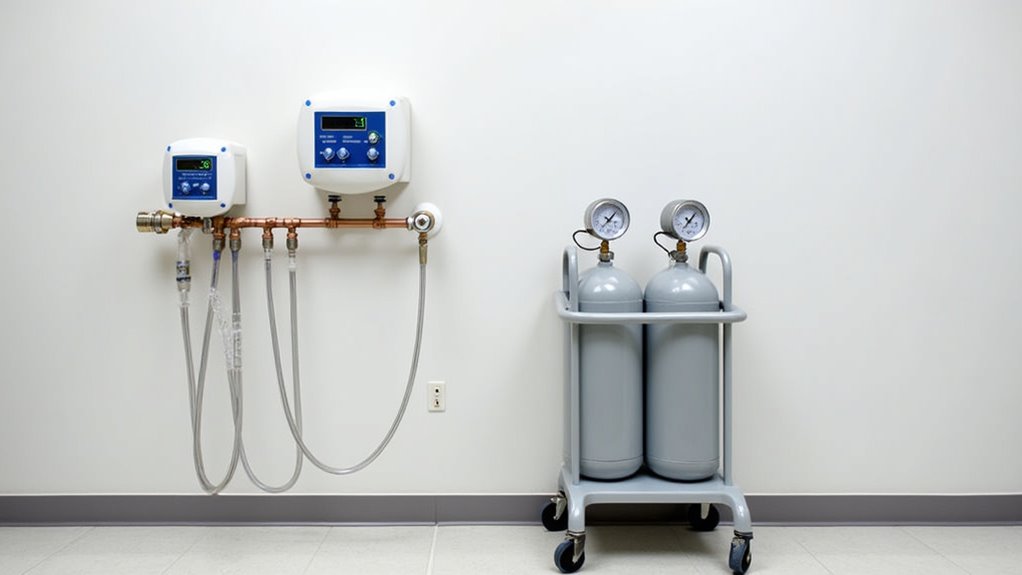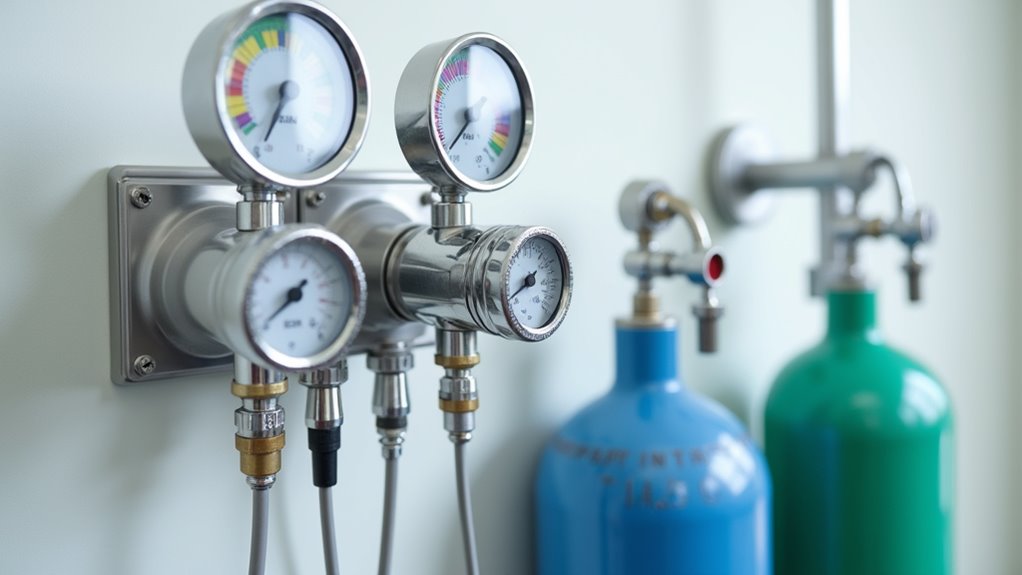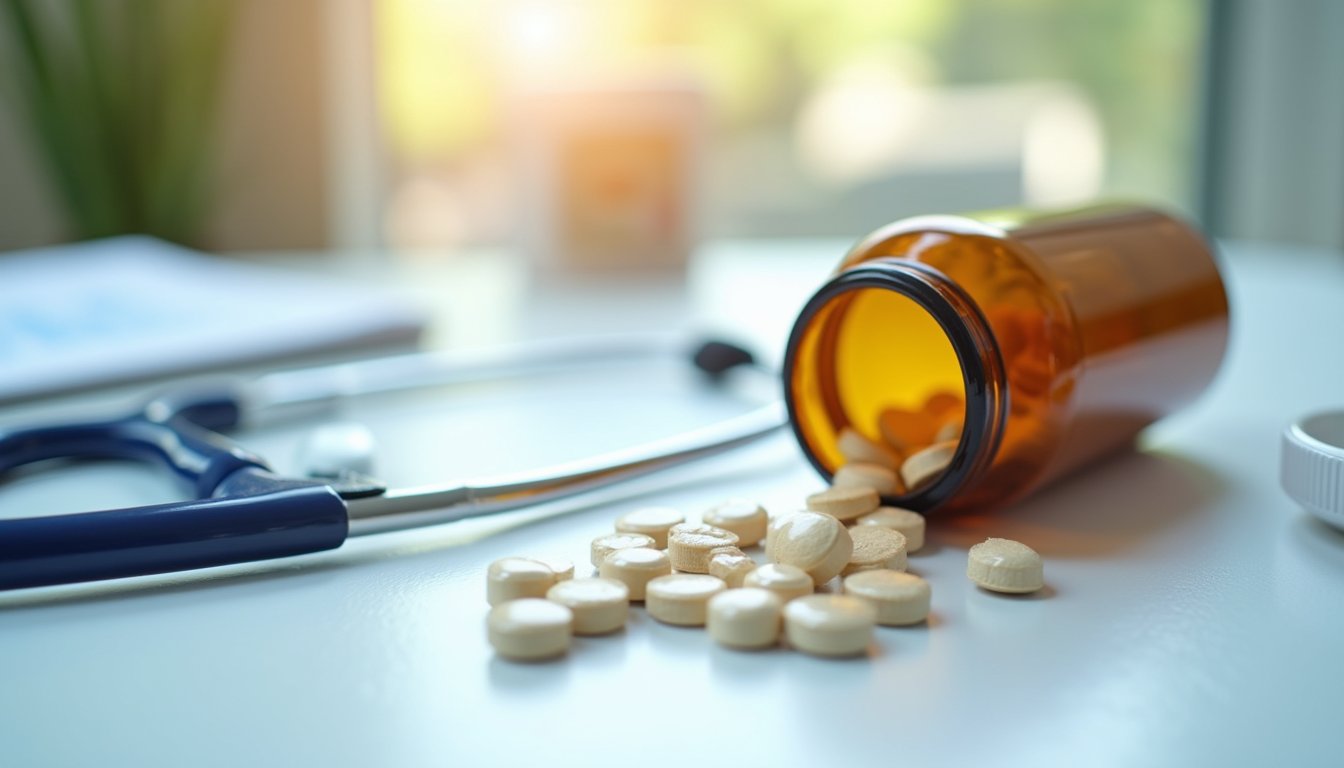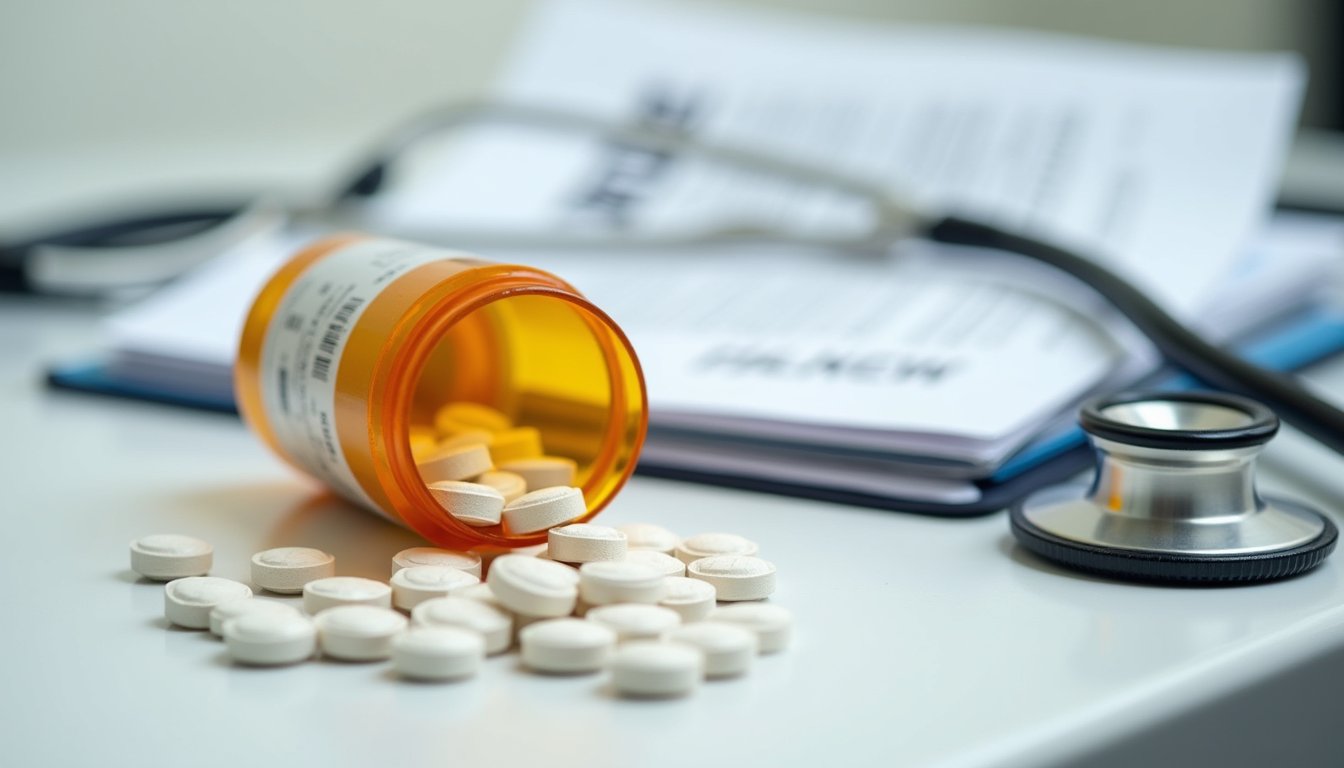Modern clinics typically use two main N₂O delivery system types: plumbed or portable units. You’ll find plumbed systems in facilities regularly offering sedation, featuring built-in digital flowmeters and larger H/G cylinders for consistent service. Portable units provide flexibility without structural modifications. Both configurations must include failsafe mechanisms, pressure regulators, and scavenging systems maintaining 45 L/min flow rates. Understanding your facility’s specific needs will guide ideal system selection.
Understanding Plumbed vs. Portable N₂O Systems

When choosing between plumbed and portable nitrous oxide delivery systems, dental practices must carefully evaluate their operational needs, facility constraints, and long-term objectives. Plumbed systems require significant facility layout requirements, including infrastructure modifications and ASSE 6010-certified plumbers for installation through drop ceilings or basements. They’re ideal for practices regularly offering sedation services and prioritizing long-term cost efficiency. Practices can achieve reduced operating expenses by utilizing larger H/G type cylinders instead of smaller E-size tanks. Digital flowmeters provide superior infection control while maintaining consistent flow throughout procedures. Portable units offer flexibility without structural changes, making them suitable for practices with space limitations or short-term leases. While they minimize initial costs and staff training protocols, they demand more operational effort for setup and cylinder management. Your choice should align with usage frequency, available space, and budget considerations. Both options require strict adherence to safety standards and regular maintenance to guarantee compliant N₂O delivery. Medical facilities often install ceiling-mounted outlets for nitrous oxide to prevent trip hazards and improve staff circulation during procedures.
Essential Components for Safe Gas Delivery
Safe nitrous oxide delivery systems require multiple integrated components working in harmony to maintain precise gas concentrations and flow rates. Through precision calibration and continuous monitoring, these systems guarantee patient safety while delivering controlled sedation. Modern systems utilize continuous measurements of gas flow to maintain accurate concentrations. As a class 3 medical device, nitrous oxide delivery systems must meet strict regulatory standards and safety protocols. Similar to push systems in performance applications, medical delivery systems maximize efficiency from available gas supplies.
Your system’s critical safety features must include:
- An adjustable mixture dial that precisely controls N₂O/O₂ ratios between 30%-70% N₂O and 30%-100% O₂
- Failsafe mechanisms that prevent gas delivery if oxygen levels drop below 30% or if N₂O flows without oxygen
- Pressure regulators that maintain consistent gas pressure output and reliable flow rates
You’ll find these components working alongside oxygen analyzers, demand valves, and pressure relief systems. Each element undergoes regular inspection protocols to verify proper function, assuring your patients receive safe and effective sedation therapy while maintaining strict compliance with safety standards.
Safety Protocols and Regulatory Compliance

You’ll need to maintain scavenging systems through regular inspections, including daily checks of rubber goods, hoses, and mask seals to prevent N₂O leakage into the operatory environment. Your leak detection protocols must include systematic testing of all connections and fittings using approved gas detection equipment, with immediate documentation and repair of any identified leaks per regulatory requirements. To guarantee effective scavenging efficiency, you must verify proper flow rates and vacuum pressure levels while monitoring exhaust discharge points for potential system backflow or contamination. Regular air sampling should maintain nitrous oxide concentrations at or below 25 ppm limits to protect staff health. Storage areas require fire-rated walls and appropriate doors to ensure containment in case of emergencies. Dental hygienists must ensure they are operating within their state-specific scope when administering nitrous oxide, as regulations vary significantly across jurisdictions.
Scavenger System Best Practices
Maintaining regulatory compliance for nitrous oxide scavenger systems requires strict adherence to multiple safety protocols and standards. You’ll need to guarantee proper gas cylinder storage in well-ventilated areas and implement continuous exposure monitoring to keep N₂O levels below regulatory limits.
Your scavenging system must meet these critical requirements:
- Maintain active scavenging flow rates of 45 L/min at the nasal mask, using FDA-cleared systems like MINISCAV® to effectively remove gas residues
- Perform daily inspections of all system components, including pressure-relief valves and quick-connect fittings
- Verify ventilation rates of 12-15 air changes per hour, with properly positioned low-level extractor fans to prevent gas accumulation
Modern systems achieve 99% nitrous capture through advanced vacuum technology and specialized venting mechanisms. Installing demand valve systems near emission sources significantly reduces occupational exposure risks and improves overall gas containment. Remember to test the scavenging system’s integrity regularly and maintain detailed maintenance logs to demonstrate ongoing compliance with OSHA and CDC protocols.
Leak Detection Requirements
Building upon proper scavenging practices, thorough leak detection protocols form the backbone of N₂O safety compliance. You’ll need to implement regular testing protocols that align with AS2896-2021 standards, including pressure monitoring systems that trigger alarms at 20% drops below 415kPa.
Your integrated monitoring systems must incorporate multiple detection methods. Medical facilities must ensure that all gas distribution uses FDA-regulated pharmaceuticals. Start with pressure testing by isolating the system for 4 hours, maintaining detailed records of baseline measurements and ambient conditions. You’ll also need to conduct flow monitoring using specialized equipment to compare source and delivery rates. For improved precision, consider implementing acoustic imaging technology, which lets you visualize leaks from up to 50m away without disrupting clinical operations. Document all test results, timestamps, and personnel involved to maintain regulatory compliance.
Digital Innovations in Modern N₂O Systems
While traditional nitrous oxide systems relied on manual controls, modern digital innovations have revolutionized N₂O delivery through precision-driven technology. Today’s enhanced ergonomic design incorporates digital interfaces with intuitive controls, while improved data analytics enable real-time monitoring of gas concentrations and system performance. However, even with these advances, systems must account for the fact that nitrous oxide has an inherently high MAC value, which impacts its effectiveness. The inclusion of portable designs has made these systems more versatile across different healthcare settings.
You’ll find these key digital advancements in modern N₂O systems:
- Digital flow meters with concentration locking mechanisms that prevent accidental overdose and sustain precise titration
- Real-time alert systems that monitor critical events, gas levels, and maintenance needs
- Auto-switching manifolds that seamlessly activate backup cylinders to prevent treatment interruptions
These innovations guarantee safer administration while maximizing operational efficiency. With digital presets and automated safety protocols, you’re able to maintain consistent sedation levels while focusing on patient care. The inclusion of dual readouts for nitrous oxide and oxygen mixtures provides healthcare professionals with enhanced precision control over sedation delivery.
Cost Analysis and Return on Investment

When evaluating N₂O delivery systems, you’ll find that initial equipment investments of $6,500 for portable units can generate revenue through per-session fees ranging from $75-$150. Your operational costs, including tank refills under $50 and delivery fees of approximately $20 per order, must be weighed against the potential income from time-based billing at $124 per 15-minute increment. The long-term financial benefits become evident as portable systems minimize gas leakage and maintenance expenses, typically achieving ROI within two years through reduced operational costs and consistent revenue streams.
Equipment Costs Vs Revenue
The financial viability of nitrous oxide delivery systems depends on three key factors: initial equipment investment, ongoing operational costs, and revenue potential. Your capital expenditure recovery timeline varies considerably between portable and central systems, with portable units offering faster ROI despite more frequent tank replacements.
For operational cost optimization, consider these critical factors:
- Tank delivery fees ($14.25 + $5.90 fuel surcharge) impact your per-procedure costs
- System maintenance requirements affect long-term operational expenses
- Equipment downtime directly influences your revenue generation capacity
You’ll typically recover your investment faster with portable systems, though central systems may prove more cost-effective in high-volume practices. With average hourly charges of $58, you can achieve positive returns within months, especially when incorporating nitrous oxide fees into your procedural costs.
Long-term Financial Benefits
Investing in nitrous oxide delivery systems yields substantial long-term financial returns through multiple cost-saving channels. You’ll experience reduced gas wastage through dynamic flow adjustment systems, with some facilities reporting up to 95% reduction in nitrous oxide consumption. Equipment depreciation rates remain favorable as portable systems demonstrate durability and infrastructure reusability.
Your clinic can generate an additional $34,500+ annually through expanded in-office procedures while eliminating OR-related expenses. The infrastructure investment typically pays for itself within two years through gas savings and increased procedural capacity. You’ll benefit from reduced environmental compliance costs and amplified operational efficiency, performing up to 12+ procedures daily. E-cylinder adoption and modern delivery systems minimize waste, addressing the 90% loss rate common in traditional piped systems.
Patient Benefits and Treatment Applications
Modern nitrous oxide delivery systems provide multiple patient benefits and treatment applications across diverse medical disciplines. You’ll find these systems enable multimodal pain management while delivering improved patient satisfaction through conscious sedation and anxiety reduction.
Key clinical advantages include:
- Up to 45% pain reduction during procedures while maintaining patient consciousness and communication
- Rapid onset of action with minimal recovery time, supporting efficient patient throughput
- Safe administration protocols with oxygen blending ratios ≥30% and automated monitoring systems
You’ll achieve ideal results across multiple specialties, from dental procedures to obstetrics and oncology. The systems support standardized delivery methods while allowing flexible concentration adjustments based on individual patient needs. With proper safety protocols, you can confidently implement these systems for both single-use and repeated applications.
Best Practices for System Maintenance
Maintaining nitrous oxide delivery systems calls for rigorous adherence to safety protocols and systematic inspection schedules. You’ll need to implement daily inspection routines that focus on checking nozzles, regulators, and valves for contaminant buildup. Your operator training protocols should emphasize proper documentation of all maintenance activities and safety checks.
To guarantee system integrity, you must conduct regular pressure monitoring and confirm emergency shutoff mechanisms. It is crucial to store tanks in well-ventilated areas where temperatures remain below 25°C and maintain local exhaust systems that keep N₂O concentrations under 25 ppm TWA. Don’t forget to test flow meters regularly and inspect protective caps on unused connections. Following industry standards like EIGA Doc 33 and ISO 23208 will help you preserve optimal system performance and safety compliance.
Frequently Asked Questions
How Long Does a Typical Nitrous Oxide Tank Last Before Replacement?
You’ll find that a typical nitrous oxide tank lasts 5-6 hours of intermittent use, supporting 20-30 procedures at 50% concentration. While tank pressure remains at 750 PSI until near depletion, you can’t rely solely on pressure readings to determine tank capacity. You’ll need to track usage manually or measure tank weight. For safety and uninterrupted service, you should replace tanks after approximately 15-minute sessions per case.
Can Patients Drive Themselves Home After Nitrous Oxide Sedation?
While you technically can drive after nitrous oxide sedation, you shouldn’t immediately head to your car. Follow your dentist’s patient recovery time protocols, which typically require a 15-30 minute observation period. Even though nitrous oxide clears from your system quickly, nitrous oxide safety protocols recommend waiting until you’re fully alert and coordinated. Your dentist will assess your readiness to drive based on your individual response to the sedation.
What Happens if There’s a Power Outage During Nitrous Administration?
If you’re receiving nitrous oxide during a power outage, your safety remains the priority. Most modern facilities have backup generators that activate automatically. However, if backup power isn’t available, your delivery system’s battery power will maintain function temporarily. Your healthcare provider will immediately discontinue nitrous administration, switch to 100% oxygen, and monitor you closely. They’ll follow established safety protocols to ensure your safety during the change.
Are There Age Restrictions for Nitrous Oxide Sedation in Dental Procedures?
While there’s no absolute age restriction for nitrous oxide sedation, you’ll find most providers follow a practical minimum age of 4 years due to cognitive development requirements. You’ll need to meet patient consent requirements and must guarantee the child can understand and follow basic instructions. For all ages, you must maintain continuous monitoring of critical signs. For patients under 4, you’ll typically need to examine alternative sedation methods or behavioral management techniques.
How Soon After Eating Can a Patient Receive Nitrous Oxide Treatment?
You’ll typically need to ponder the time interval between meals and treatment carefully. For grownups, you can have light meals a few hours before treatment, though fasting requirements prior to administration vary by provider. Youngsters should follow a stricter three-hour fast. It’s best to steer clear of heavy meals regardless of maturity, as they may increase nausea risk. Always follow your provider’s specific instructions, as they’ll adjust guidelines based on your health history.









